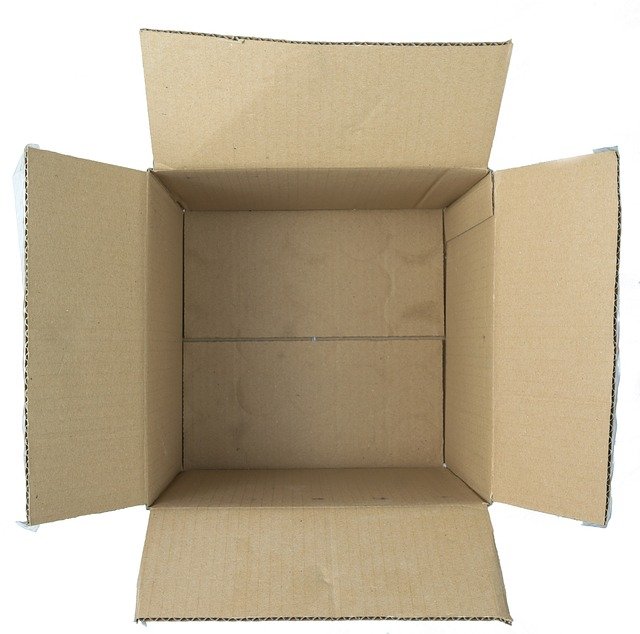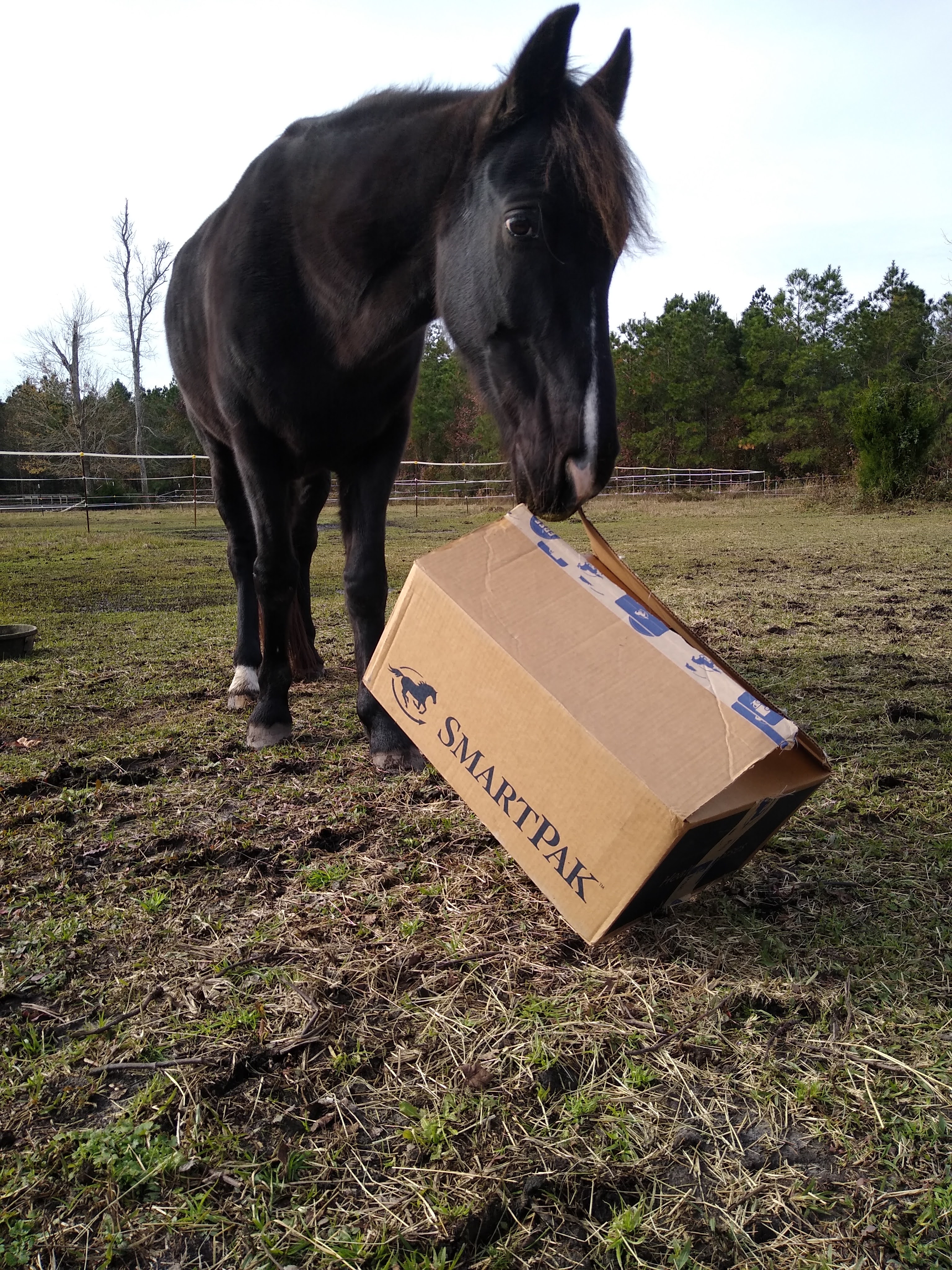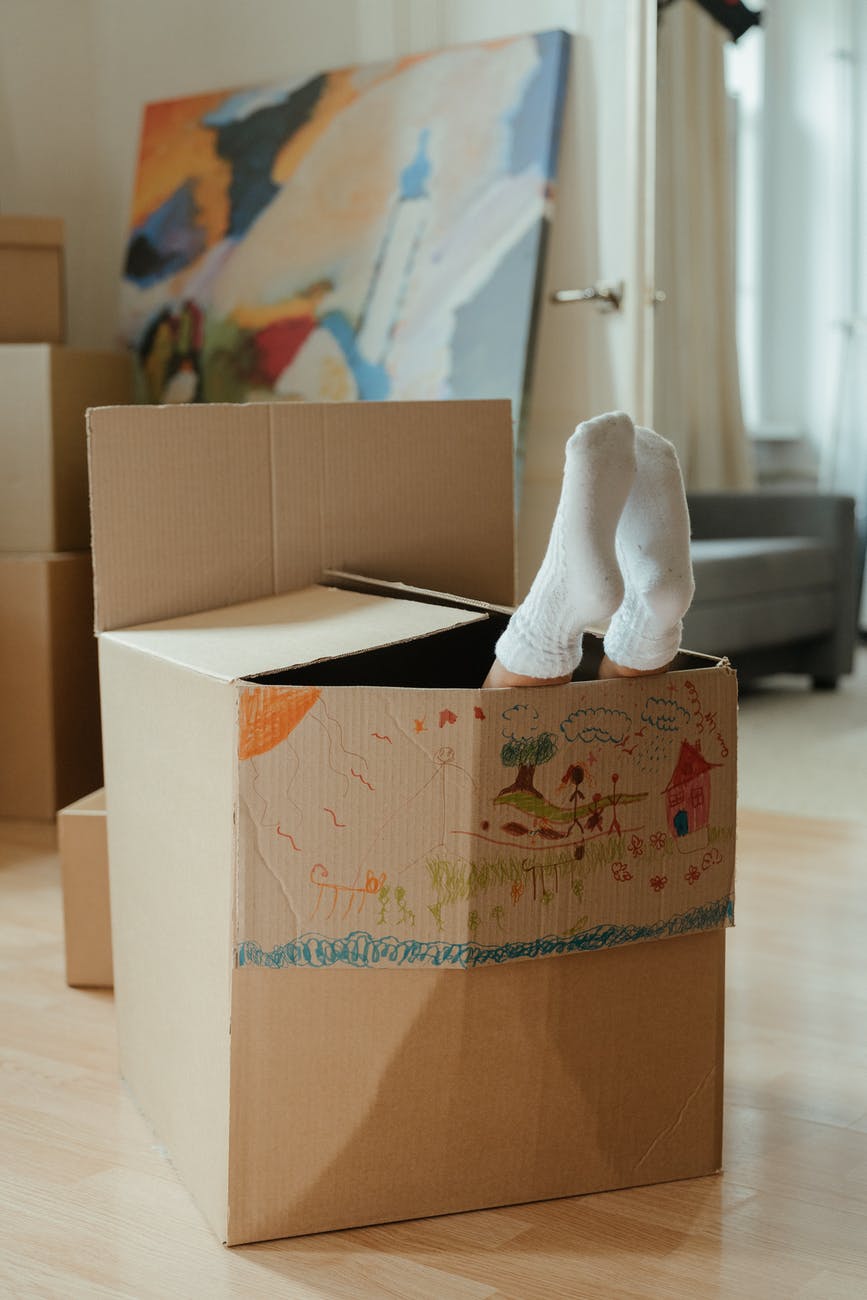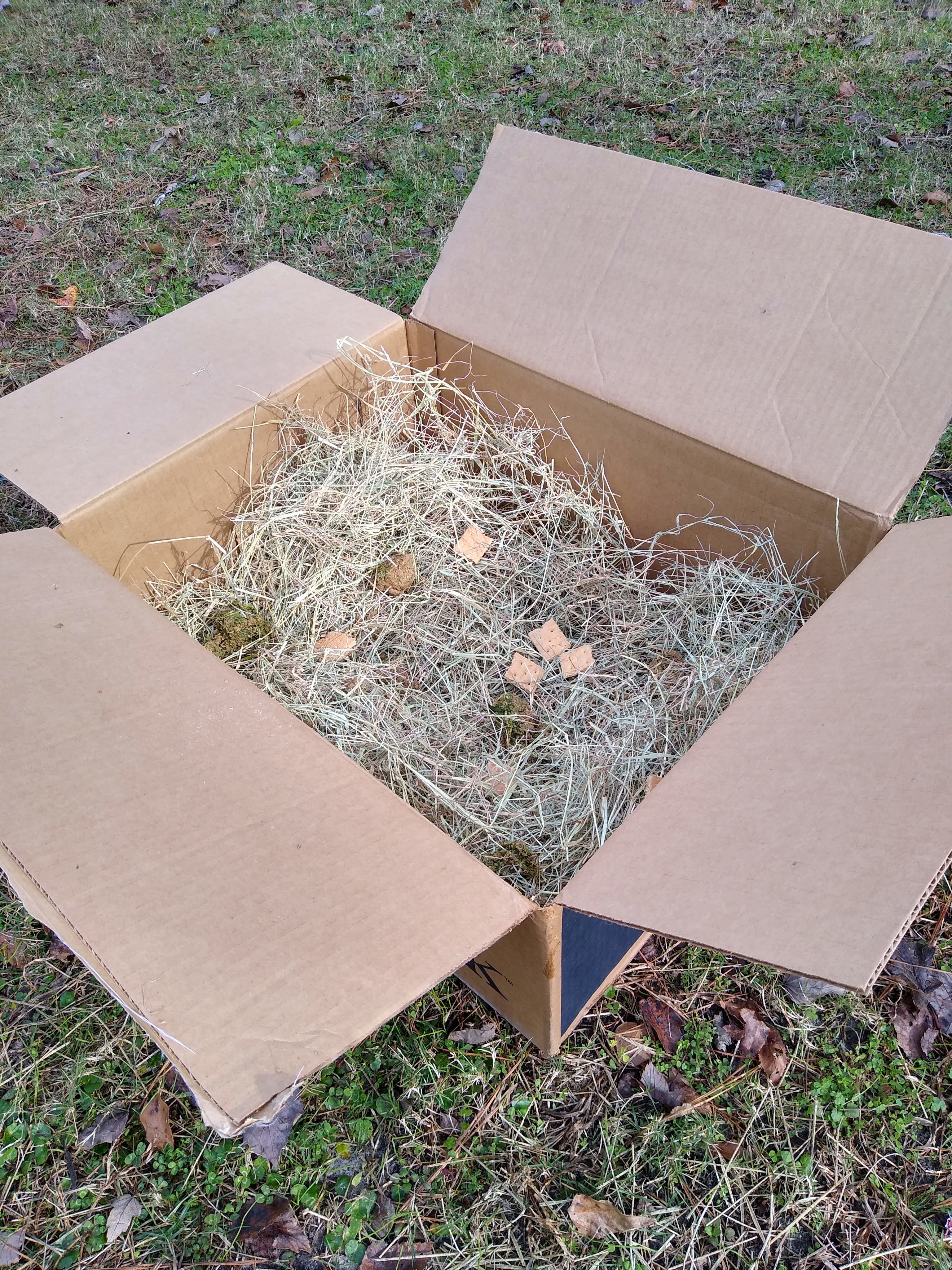If you’ve ever been on the internet, you know animals love cardboard boxes. But did you know that you can use a cardboard box to make a fast, free toy for horses? A forage box for horses is the perfect easy DIY toy for horse owners on a budget. It relieves boredom and encourages natural behavior – and it’s just plain fun! Here’s how to make a cardboard forage box toy for your horse.
What Is a Forage Box for Horses?
A forage box for horses is a cardboard box with edible goodies inside. It’s an enrichment item for your equine friend.

You can make a forage box by layering hay and tasty treats inside a cardboard box, or by hiding treats around crumples of paper for your horse to sort through. There’s endless variety with this horse toy.
Depending on how the box is set up, a forage box gives your horse a bit of challenge and doubles as a treat puzzle and slow feeder. There are almost limitless combinations of box size, difficulty level for the horse to access, and type and amount of food on the inside.
For just a little effort to source and set it up, you can provide a cardboard forage box for your horse and create a fantastic enrichment opportunity. And with so many potential options for the box, this is one enrichment that can be tweaked and varied for endless variety – no getting bored of this activity for most horses! We’ll cover the steps to DIY a forage box for your horse below.
Why the Forage Box is Good Enrichment For Horses
This DIY horse enrichment toy is safe, easy to use, and entertaining.

It’s perfect for horse (and owners) who are new to enrichment. After all, it’s a container with food inside – just like a bucket of feed! So if your horse is just learning to use puzzles and toys, a forage box makes a perfect beginner-level horse enrichment item.
Horses love forage boxes because they add variety and stimulation. Eating out of a bucket is satisfying, but foraging for food by snuffling through a forage box is fun! It also provides sensory variety, which is important for keeping your horse engaged and free from boredom.
A forage box is also very simple and fast to make, and is completely free. That’s a huge perk because when enrichment is easy, you’ll be able to do more of it! The best enrichment is regular enrichment. A forage box for horses is such a simple DIY that you can put one together once or twice a week if you like.
What Behaviors Does the Forage Box for Horses Encourage?
Enrichment for horses is all about encouraging natural behaviors. A cardboard box isn’t exactly natural, but it’s perfect for getting your horse to use their mind and have a good time foraging.

A forage box for horses encourages:
- Problem solving
- Foraging and looking for food
- Sensory behaviors like touch, smell, and taste
Forage box first-timers get to experience something new. That’s good enrichment in itself: keeping things fresh and exciting is an important strategy to stave off equine boredom.
Once they explore the box and figure out that it contains food, your horse will problem-solve to grab the goodies. Depending on how you set up the box, they’ll experience a little challenge as they go for the food.
How to Make a Forage Box for Horses
Creating a forage box for horses is really simple. The fun part is deciding what to put inside the box. Here’s how to make a great forage box, step by step.
Step 1: Find Your Box

Cardboard boxes are everywhere and you should be able to get one for free. You can use a box of any size for this enrichment – you’ll need to make up a new one after every few uses, which gives you a great chance to vary the size. Most forage boxes will be at least as large as a shoebox, the bigger the better, but they can be any size. The next time you get an Amazon delivery, save the box!
Ask around at work or at large stores for shipping boxes. They arrive all the time and most places have a cardboard bin in the back that you can get a few large boxes from.
It’s more convenient to find boxes that haven’t been broken down yet, but a large amount of freebie boxes will be flat. If you get a flat box, it’s easy to put it back together with a little masking tape.
You should be aware of safety when making any enrichment and forage boxes are no exception. Make sure each box you select is clean – don’t use boxes with weird stains. No greasy pizza boxes! Some cardboard boxes meant for fresh produce come with a thin wax coating, which is fine for this enrichment but does mean that the cardboard cannot be recycled – after use, make sure it goes into the trash rather than the recycling bin.
Don’t use boxes held together with large staples. Only cardboard and tape are safe for equine use.
Step Two: Fill with Treats and Forage

Decide how you’re going to fill your box with forage. You can use any combination of food you like, such as:
- Filling the box with hay with a few apple pieces in the middle of a hay “nest”
- Placing high-value treats like horse cookies, apple, or carrot in the box while empty and then add hay on top
- Make a “box lasagna” with a layer of hay, a couple high-value treats, a layer of hay, more treats, and so on
- Soak hay cubes or beet pulp just until soft and fluffy (not wet!) and add to the bottom of the box
- Add packing paper (the brown kind that often comes with cardboard boxes) as extra filler so that the horse has to pick through it or remove it, then place the treats in and around
- Placing a box within a box with food in and around each, for extra challenge
Open or Closed Forage Box?
You’ll have to decide whether you want to offer the box open or closed. The difficulty level of the enrichment will vary based on how you close or don’t close the box. Here are a couple of ways to close the box in order of difficulty:
- Fully open box. The flaps are pressed into the open position before offering it to the horse.
- Partially closed box. The flaps are turned in slightly. The food is quite visible but the horse will have to touch or nudge the cardboard to access most of it.
- Closed with flaps down but not folded. The flaps are pressed down slightly so that the food is almost completely obscured and the horse will has to figure out how to lift or push down the flaps.
- Closed with flaps down and “folded closed.” The box is totally closed by folding the flaps over one another – the most difficult way to offer a box because the horse will have to really lift, pull, and bite at the flaps to open the box.
- Closed/partially closed but “sneak holes” cut into sides so horse can see, sniff, and pull out hay.
The fully open box is the most accessible and simplest for the horse, and is probably where you’ll want to start if this is your horse’s first forage box or if they’re not used to food-based puzzles.

If you start by offering an open box – encouraging the various behaviors involved in investigating and feeding – you can increase the difficulty level by closing up subsequent boxes so that the horse gets some problem-solving experience too. Stepping up the difficulty gradually by moving through box types 1 through 4 in order will ensure that most horses figure out even the hardest-to-open box.
Step Four: Forage Box Fun Time
Once you’ve made your horse a forage box, it’s time to have fun with it!
It’s best to introduce all enrichment slowly and in an open area, not inside a stall. Let your horse figure out how much fun a forage box is in their paddock. Then, when they are comfortable with the box, you can use it in an enclosed area.
If your box is really big, you should take it out of the horse’s stall so that they have plenty of room.
It’s important to observe your horse when they use enrichment. You’ll need to make sure that they are using their forage box toy safely and not trying to eat the cardboard – this is rare but sometimes happens! Don’t leave your horse unsupervised with the box until you’re sure that they use it safely.
When you make a few forage boxes for your herd, you’ll be able to tell what kinds your horse prefers. You can vary the treats and forage used inside for endless variety.
Forage Box Safety
Safety should always be a priority when making toys for horses.
Don’t use any food that isn’t horse-safe, and make sure you use treats that are a safe size and texture for your horse.
All the forage box add-ins like crumpled paper or old cartons should be horse-safe with no sharp edges. The box itself should be clean and free of loose tape or shipping staples.
When your forage box gets wet or starts to wear out, just replace it with another one. After all, this enrichment is free!
If you want to take a deep dive on designing safe horse toys and enrichment, try the ebook Safe Equine Enrichment available here!
Related Horse Enrichment
Forage boxes are easy, budget-friendly horse toys. They are a puzzle feeder and slow feeding device. Here’s inspiration for similar enrichment concepts:
Easy Cardboard Puzzle from a Shipping Tray
